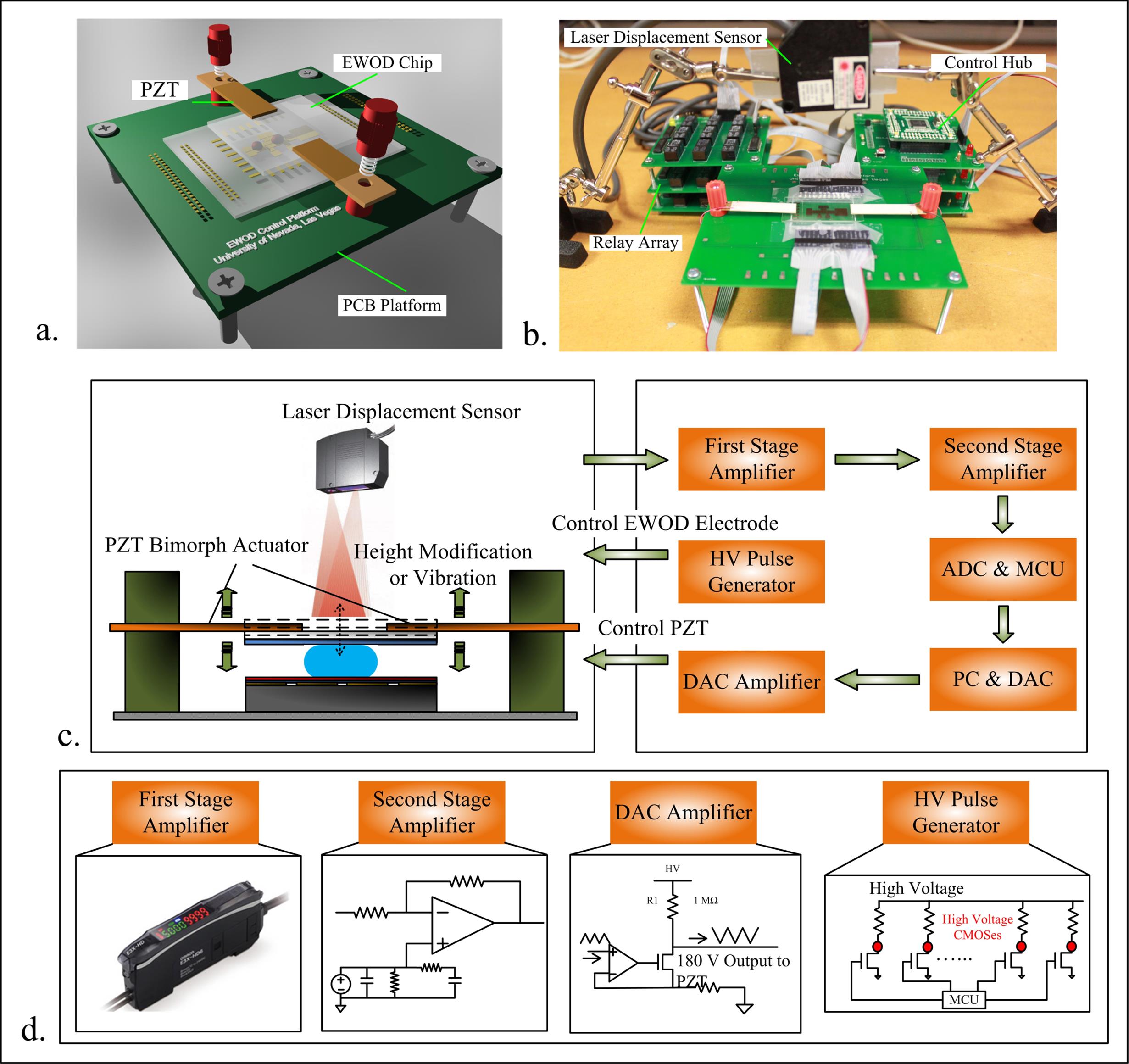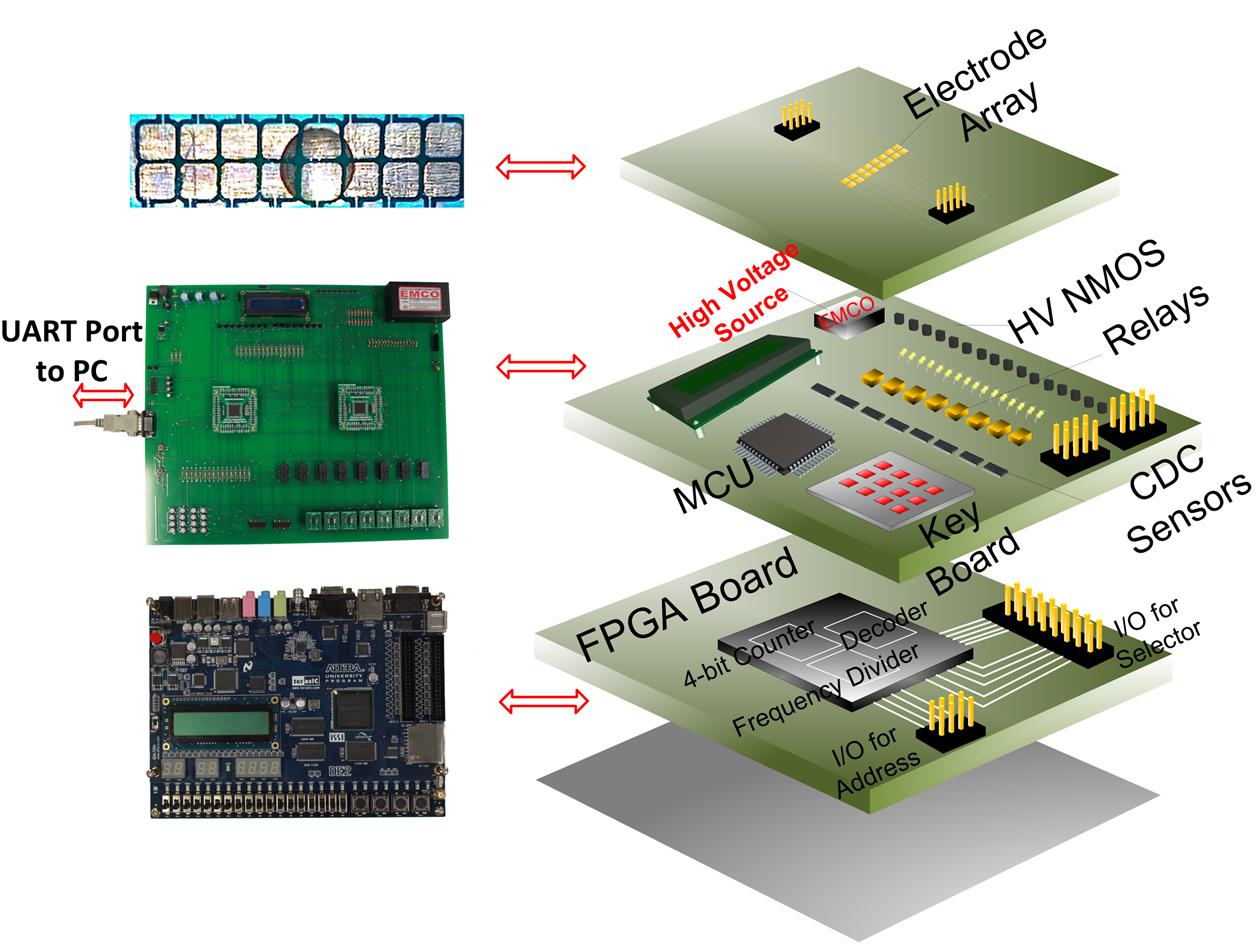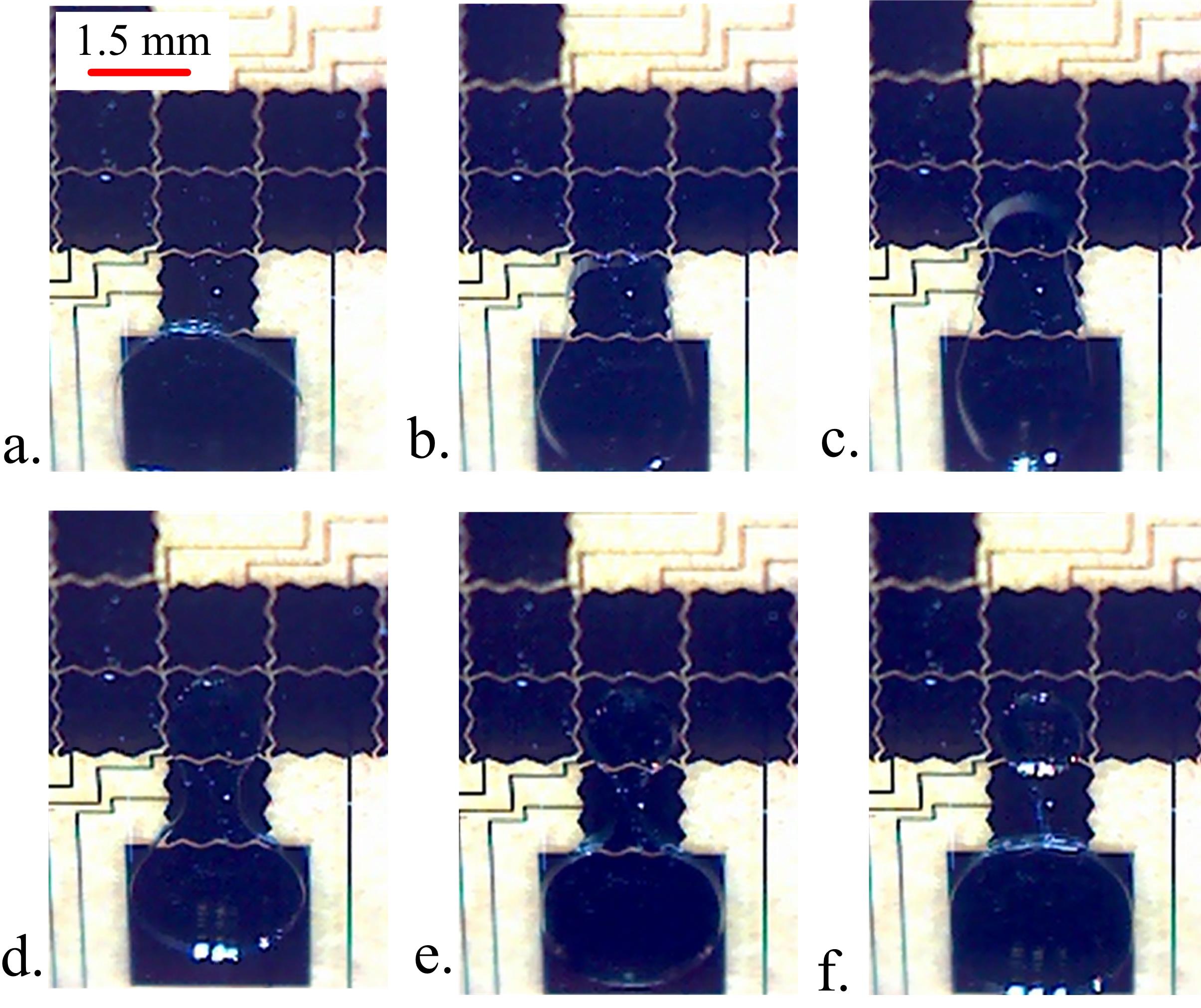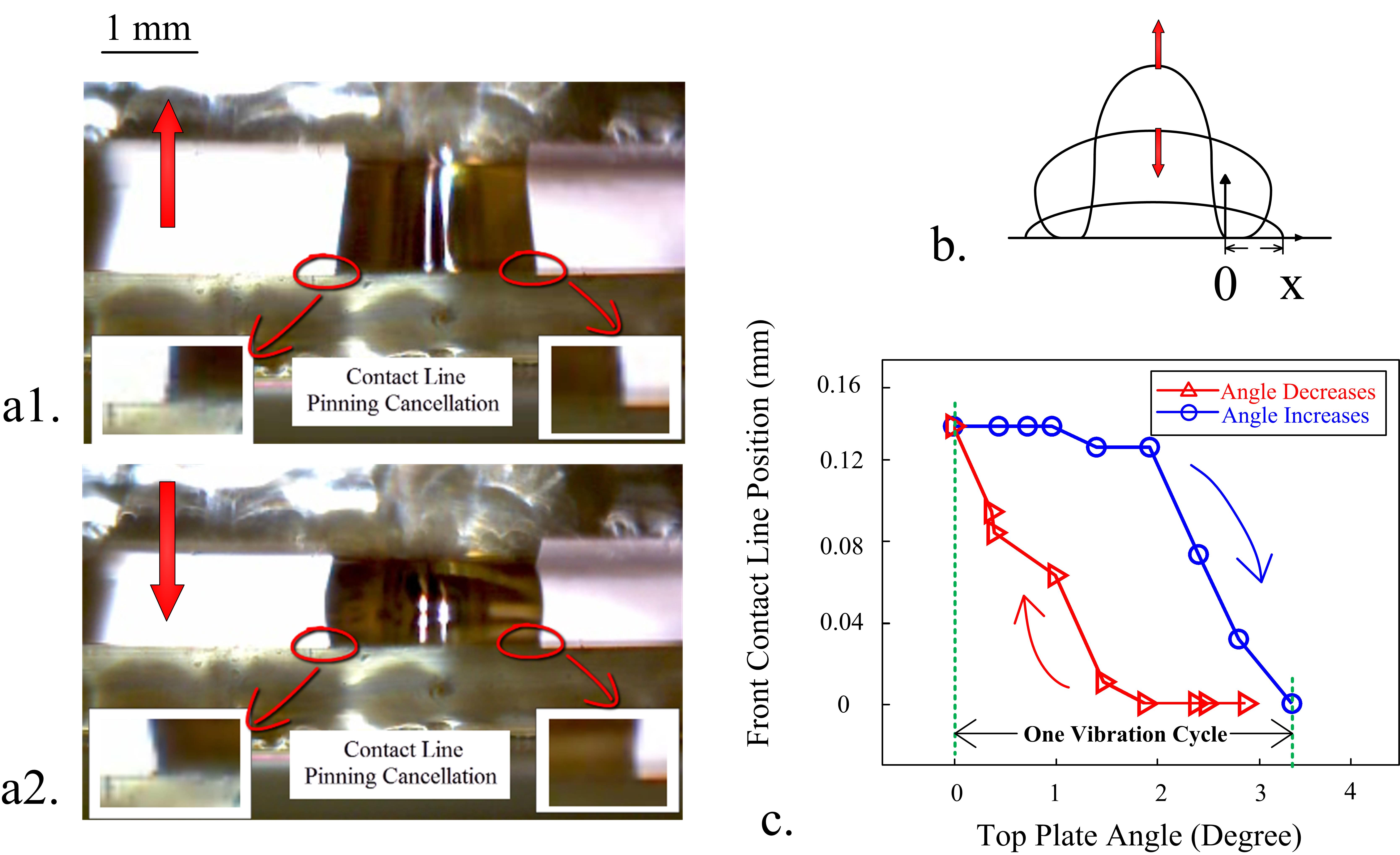|
|
High
throughput microfluidics We are experts on microfluidics. Those technologies include single cell droplet encapsulation, high throughput droplet generation (from AutoCAD to a real chip), on-chip sensors/actuators, detectors, electrodes, and all other tools for on-chip laboratory automation. Scientific instrumentation (hardware/software) being interfaced with those sensors can be developed within a milestone-driven project. More links: https://www.youtube.com/watch?v=W5B7Tq4U934 https://www.youtube.com/watch?v=QGYGldsHyc0 New Chip Design |
 |
Electrowetting
on a CMOS
Integrated Cirtuit Chip Electrowetting is the physical phenomenon in which a polarizable liquid droplet sees an increase in its contact angle in the presence of an electric field. The ability to create, merge, split, and move sub-microliter droplets on the surface of chip will increase bio-analysis efficiency as it will reduce both the time needed to reactions to run to completion and the volume of reactant/biological sample required. Applications included protein sensing, DNA sequencing, and cell sorting. Using standard CMOS chips provides a great solution for fabricating the micron level electrodes. With this consideration, we utilize the ON Semiconductor’s C5X High Voltage technology to overcome this problem. The 20V devices are giving higher voltage limitation than that reported in previous literatures, thus we expect moving, merging and splitting would work directly on the top layer of the chip. |
 |
PZT
DMF Top Plate Control An
intelligent EWOD top plate control system is proposed in this study.
The dynamic top plate is controlled by a piezoelectric (PZT) cantilever
structure. A High resolution laser displacement sensor is used to
monitor the deflection of the top plate. The gap height optimization
and the harmonic vibration significantly improve the droplet velocity
and decrease the minimum threshold actuation voltage for droplets
ranging from 0.2 無 to 2.0 無. The top plate vibration induced
actuation improvement is magnitude and frequency dependent. The maximum
droplet instantaneous velocity is around 9.3 mm/s,
which is almost 3 times faster than the droplet velocity without top
plate vibration. Small droplet rescue is also discussed and tested. The
top plate control technique reported in this study makes EWOD DMF chips
more reliable when used in the clinical point-of-care diagnostic
applications.
|
 |
PCB-DMF
Capacitive Sensing A
low-cost and high-resolution capacitive-to-digital converter integrated
circuit is used for droplet position detection in a digital
microfluidic system. A field-programmable gate array FPGA is used as
the integrated logic hub of the system for a highly reliable and
efficient control of the circuit. A fast-fabricating PCB (printed
circuit board) substrate microfluidic system is proposed. Smaller
actuation threshold voltages than those previously reported are
obtained. Droplets (3 無) are actuated by using a 200 V, 500 Hz
modulating pulsed voltage. Droplet positions can be detected and
displayed on a PCbased 3D animation in real time.
|
 |
DMF
Fabrication A highly efficient and reliable electrowetting on dielectric (EWOD) digital microfluidics (DMF) chip is proposed. An 8 痠 parylene C layer is used as the dielectric material. Extra vapor-phase silane (VPS) is introduced into the chamber and acts as an aerosol primer to enhance the chemical adhesion to the parylene C surface. The EWOD chip can perform droplet dispensing, merging and splitting. Dual electrode dispensing mode (DEDM) and single electrode dispensing mode (SEDM) are tested to investigate the dispensing volume accuracy. Small deviations (0.0467 無 for DEDM and 0.0303 無 for SEDM) are observed for the dispensing. Droplets from 1.5 無 to 2.3 無 are tested for the minimum splitting voltage. Larger droplets require larger voltages to be split. The proposed EWOD chip is promising for future point-of-care clinical diagnostics. |
 |
Non-Parallel
DMF Devices Droplet transportation in a beak-like EWOD (electrowetting on dielectric) DMF (digital microfluidics) device is investigated in this study. For a sessile DI water droplet (4 無) on a 250 nm Teflon AF solution (1%) coated hydrophobic surface, the droplet front edge has a smaller contact angle variation than the rear edge when increase the applied voltages. No ratchet-like motion is found under a top plate beak-like vibration while there is no voltage applied to the EWOD electrode. If there is a voltage applied to wet the surface, a subtle ratchet-like motion is observed under the top plate beak-like vibration. The contact angle hysteresis is presented in a new way, which is contact line displacement hysteresis to the top plate opening angle. The contact line displacement is an exponential function while decreasing the top plate opening angle and a logarithmic function while increasing the top plate opening angle, thereby this hysteresis can be modeled by classic magnetic hysteresis methods. |
 |
Negative
Index Metamaterials An ultra-thin flat lens is proposed for focusing circularly polarized light in the visible range. Anisotropic C-shaped nanoantennas with phase discontinuities are used to form the metasurface of the lens. The phase response of the C-shaped nanoantennas can be manipulated by simply rotating the angle of the unit nanoantenna. A 600 nm incident circularly polarized light is focused by the proposed techniques. Good agreements are observed by using our MoM and a commercial FDTD software package. The computation time spent by using MoM is approximately 10–100 times smaller than using FDTD. All the results show the proposed nanoantenna array has a great potential for nanoscale optical microscopy, solar cell energy conversion enhancement, as well as integrated optical circuits |
 |
Non-Invasive
Brain Stimulation in Rodent Animals Single-session anodal transcranial direct current stimulation (tDCS) can improve the learning-memory function of patients with Alzheimer’s disease (AD). After-effects of tDCS can be more significant if the stimulation is repeated regularly in a period. Here the behavioral and the histologic effects of the repetitive anodal tDCS on a rat model of AD were investigated. The behavioral and the histological experiments indicate that the proposed repetitive anodal tDCS treatment can protect spatial learning and memory dysfunction of Abeta–40-lesioned AD rats. |
 |
Surface-Enhanced
Raman Spectroscopy Periodic broccoli-shaped Au and Ag surface-enhanced Raman spectroscopy (SERS) arrays were fabricated by combining ordered SiO2 colloidal crystal templates with the physical deposition technique. The SiO2 colloidal rystal-assisted Au and Ag SERS substrates have a long-range, adjustable periodic structure and a clean surface without incorporating any reductants or surfactant chemicals. Different from depositing directly on the flat substrates, the colloidal crystal-assisted nanostructure array has a larger effective surface area under the same projected area of laser irradiation, which exposes more “hot spots”. |
Go back to yilectronics.com

